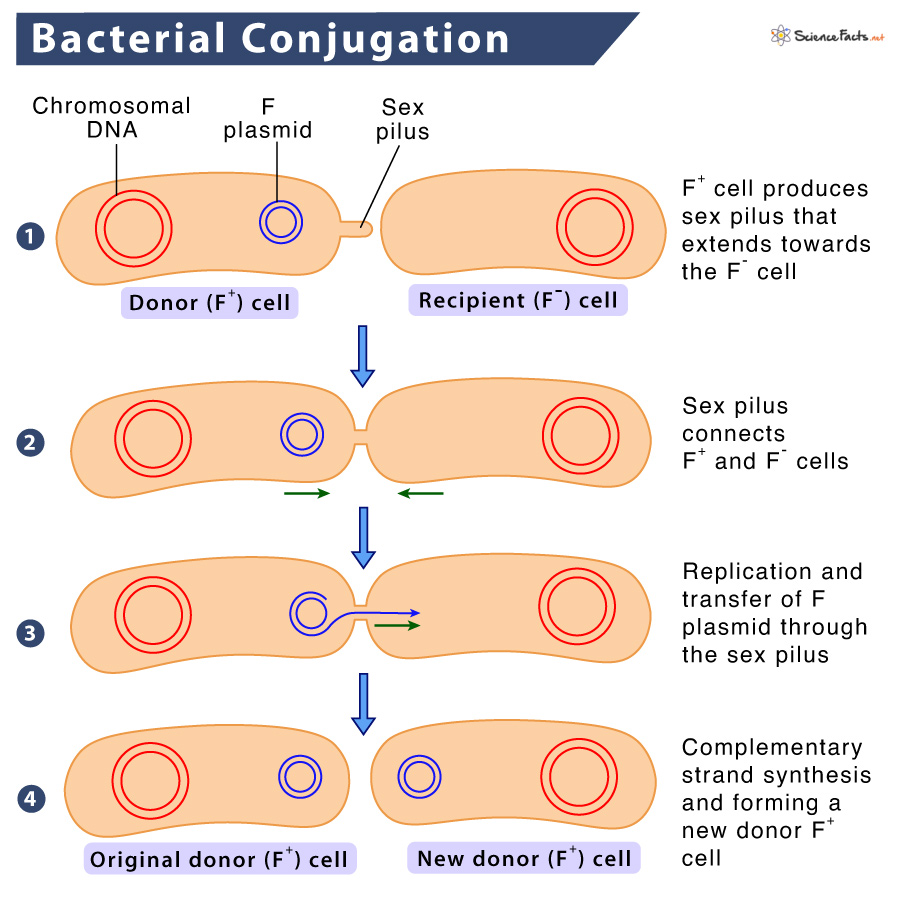Principle
Steps of Bacterial Conjugation
Types of Bacterial Conjugation
Examples of Bacterial Conjugation
Bacterial conjugation was first described by Joshua Lederberg and Edward Tatum in 1946 in bacteria Escherichia coli. The four basic steps of bacterial conjugation are given below:
- Pilus Formation: This is the first step of conjugation. The F+ donor cell produces the sex pilus that extends and begins contact with an F– recipient cell.
- Establishing Direct Contact between Donor and Recipient: TheF+ cell and the F– cell physically connect, forming a conjugation tube. The pilus helps to draw the two cells closer.
- Replication and Transfer of F Plasmid: The F plasmid in the F+ cell replicates by a rolling circle mechanism. A copy moves to the recipient. The F- plasmid, a double-stranded DNA molecule, is nicked and opened at its origin of replication site called ori-T.
- Complementary Strand Synthesis: This is the final conjugation step called the maturation step. Both the donor and the recipient cell contain a single strand of the F plasmid at this stage. The recipient cell ends up forming a double-stranded F plasmid identical to the original donor F plasmid. Thus, the recipient cell now contains a copy of the F plasmid and becomes an F+ donor cell that can make its pilus and transfer DNA to other cells. Thus, bacterial conjugation allows genes from two different parental cells to come together in the same cell and hence provides an opportunity for genetic recombination. a) F+ Conjugation (F+ × F– Mating): This is the one described above. It involves the transfer of an F+ plasmid but not chromosomal DNA from a donor cell to a recipient cell. b) Hfr Conjugation (Hfr+ × F– Mating): Here, an F+ plasmid integrates with the chromosome to become an Hfr+ cell. It then behaves like a donor cell that transfers its Hfr chromosome to the recipient F– cell. The bacterial connection usually breaks before the transfer of the entire chromosome is completed so the rest of the F+ plasmid cannot enter the recipient. Thus, the F– cell remains F– at the end of the transfer. c) Hfr-F’ Conjugation (Hfr+ × F’ Mating): The F plasmid, being an episome it can leave the bacterial chromosome. Sometimes during this excision, the plasmid makes an error and picks up a portion of the chromosomal DNA to form an F’ plasmid. The newly formed F’ plasmid can now mate with another F’ plasmid. The process is identical to F+ × F– Mating. The recipient becomes F– as the bacterial genes transferred from the F’ cell cannot be incorporated into the recipient chromosome for expression.
